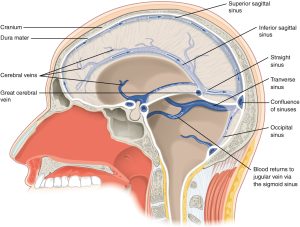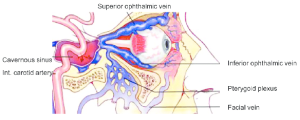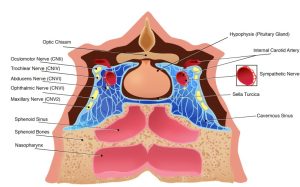Venous Drainage of the Brain
Jim Hutchins
Objective 5: Summarize the venous drainage of the brain.

The brain has few veins that resemble the round tubes found in other parts of the body. Rather, in most locations, blood collects in sinuses, open areas that collect deoxygenated blood from a network of feeder vessels.
Two main sinuses, found along the midline, are the superior sagittal sinus and the inferior sagittal sinus. A much smaller occipital sinus drains blood from the occipital area and runs along the midline as well.
Two pairs of sinuses pass laterally. The more superficial pair are the transverse sinuses. The deeper pair are the great cerebral veins (of Galen). These form a T-shaped arrangement with the straight sinus.
The straight sinus, the occipital sinus, the superior sagittal sinus, and the two transverse sinuses all come together at a single point called the confluence of sinuses. The sigmoid sinus connects all these structures to the jugular veins, which ultimately drain the deoxygenated blood from the brain.
The cavernous sinuses, near the eyes on either side of the head, are venous sinuses that contain several important structures: several cranial nerves and the internal carotid arteries. These sinuses receive drainage from the area of the nose and eyes.

For that reason, a roughly-defined three-sided region centered around the nose carries a lurid and attention-grabbing name: The Triangle of Death. The reason for this emo name is because an infection in this area can easily invade the cavernous sinus and from there the important structures carried inside. If you’ve ever been told you’ll die if you pop nose zits, this is why.
Media Attributions
- Dural sinuses and veins © Betts, J. Gordon; Young, Kelly A.; Wise, James A.; Johnson, Eddie; Poe, Brandon; Kruse, Dean H. Korol, Oksana; Johnson, Jody E.; Womble, Mark & DeSaix, Peter is licensed under a CC BY (Attribution) license
- Cavernous sinus fistula © Celik, Ozlem; Buyuktas, Deram; Islak, Civan; Sarici, A Murat; Gundogdu, A Sadi is licensed under a All Rights Reserved license
- Cavernous sinus © Kuybu, Okkes MD and Diana is licensed under a CC BY-SA (Attribution ShareAlike) license

